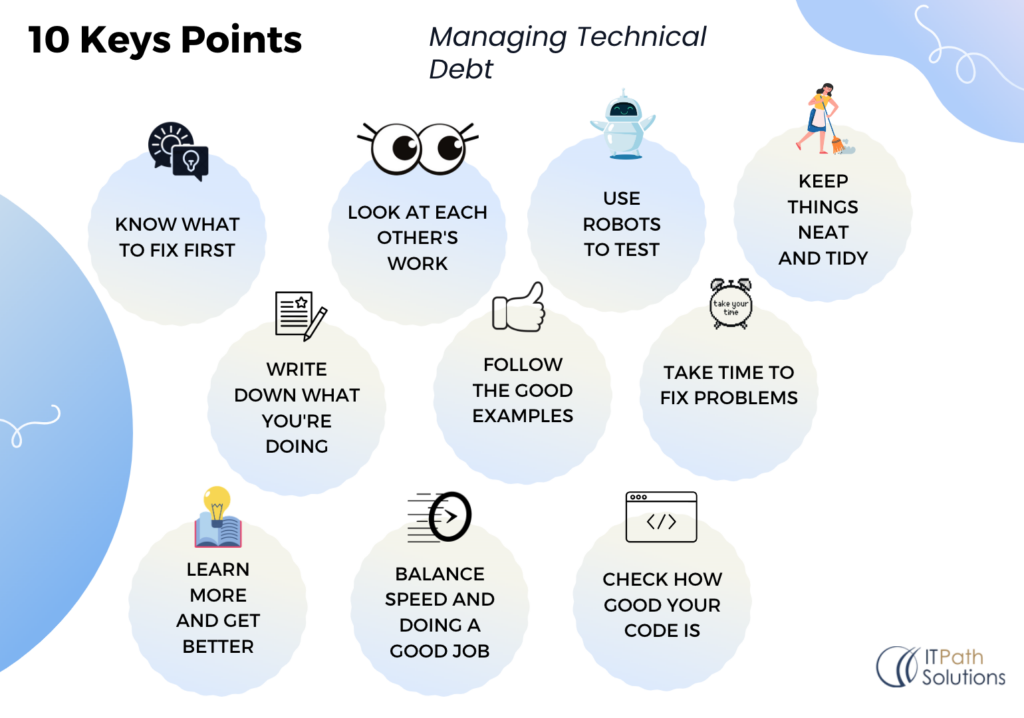Tackling Technical Debt in Software Development: Tips and Strategies
Software Application Development
Introduction
Technical debt can occur when we are working on a lengthy project and are under deadlines. It happens because in the world of software, there’s often a choice between getting things done quickly or making them perfect. Over time, these little messes pile up and can slow down future work. Fixing them is really important for keeping your software healthy and successful. In this blog post, we’re going to dive deep into some easy and practical ways to clean up these messes in your software.
Key Points for Managing Technical Debt
 Fig 1 : – Key points for Managing Technical Debt
Fig 1 : – Key points for Managing Technical Debt
-
Know What to Fix First
Imagine you’re cleaning your room. If it’s really messy, you don’t start by organizing your bookshelf when your bed is a total mess, right? Similarly, in software, not all problems are equally important. Some are like big, annoying hurdles, while others are small annoyances. You should start by figuring out which problems cause the most trouble or slow things down the most. Fixing these big issues will make a huge difference in the long run.
 Fig 2 : – Checking the bugs
Fig 2 : – Checking the bugs
-
Look at Each Other’s Work
Cleaning a room, much like collaborative work in software or app development, is a collective endeavor. Feedback and contributions from colleagues play a pivotal role in refining the overall result. In both scenarios, pooling insights and efforts leads to a more polished and efficient outcome. Just as a well-coordinated cleaning team ensures every nook and cranny is addressed, a cohesive software development team brings diverse perspectives to optimize code functionality. This collaborative spirit fosters an environment of continuous improvement, where ideas flow freely, and each individual’s strengths contribute to a more robust end product.
 Fig 3 : – Look at Each Other’s Work
Fig 3 : – Look at Each Other’s Work
-
Use Robots to Test
Envision tiny cleaning robots swiftly identifying and managing specific messes in a room. Similarly, specialized tools in software development automate tasks that would be challenging for humans.
 Fig 4 : – Use Robots to Test
Fig 4 : – Use Robots to Test
-
Keep Things Neat and Tidy
Think of your code like a room. If you let it get really messy, it’s hard to find things, and you might trip over stuff. In software, you can prevent messes by regularly cleaning up your code. This means removing stuff you don’t need and organizing things neatly. It makes your code easier to read and work with, just like a clean room is easier to live in.
 Fig 5 : – Keep Things Neat and Tidy
Fig 5 : – Keep Things Neat and Tidy
-
Write Down What You’re Doing
Just as leaving notes in a room aids understanding, comments in code explain its purpose for better comprehension in software development.
 Fig 6 : – Write Down What You’re Doing
Fig 6 : – Write Down What You’re Doing
-
Follow the Good Examples
Adhering to established methods in room cleaning parallels the significance of employing best practices in software development. Both prioritize efficiency, aiming for optimal outcomes. Just as a well-organized cleaning routine ensures a spotless space, adhering to coding standards leads to higher-quality and more readable software. Consistent approaches, whether in cleaning or coding, foster precision and effectiveness. This disciplined mindset ensures that tasks are executed with excellence, resulting in a clean room or well-structured codebase. Embracing proven methods in each domain reflects a commitment to excellence and lays the foundation for success in both room maintenance and software development endeavors.
 Fig 7 : – Follow the Good Examples
Fig 7 : – Follow the Good Examples
-
Take Time to Fix Problems
Similar to scheduling time for room upkeep, dedicating specific slots for bug fixing in software development underscores its importance, averting the accumulation of issues. This proactive approach ensures a smoother development process and higher-quality end products.
 Fig 8 : – Take Time to Fix Problems
Fig 8 : – Take Time to Fix Problems
-
Check How Good Your Code Is
Imagine a mentor inspecting your cleaning efforts, providing feedback on areas needing improvement. Similarly, tools in software development analyze code and offer suggestions for better practices.
 Fig 9 : – Check How Good Your Code Is
Fig 9 : – Check How Good Your Code Is
-
Learn More and Get Better
Similar to gaining skills for more effective room cleaning, ongoing learning and practice enhance coding proficiency and problem-solving abilities in software development.
 Fig 10 : – Learn More and Get Better
Fig 10 : – Learn More and Get Better
-
Balance Speed and Doing a Good Job
Strive to clean a room efficiently without sacrificing thoroughness, just as finding the right balance between speed and quality is crucial for success in software development.
 Fig 11 : – Balance Speed and Doing a Good Job
Fig 11 : – Balance Speed and Doing a Good Job
Conclusion
Managing technical debt is akin to caring for a beloved room. It’s an ongoing process, much like tending to your living space, one step at a time, every day. By consistently giving your software attention and employing these straightforward strategies, you’ll foster a healthy digital environment, ready to meet future challenges head-on. Just as a well-kept room provides comfort and peace, a meticulously organized codebase elevates the software development experience, guaranteeing a smooth, enjoyable journey. Remember, much like maintaining a clean and tidy room is a labor of love, so too is nurturing your codebase, and the rewards are worth every effort in the world of software development.
 Healthcare
Healthcare  Education
Education  Real Estate
Real Estate  Logistic
Logistic  Fitness
Fitness  Tourism
Tourism  Travel
Travel  Banking
Banking  Media
Media  E-commerce
E-commerce 




